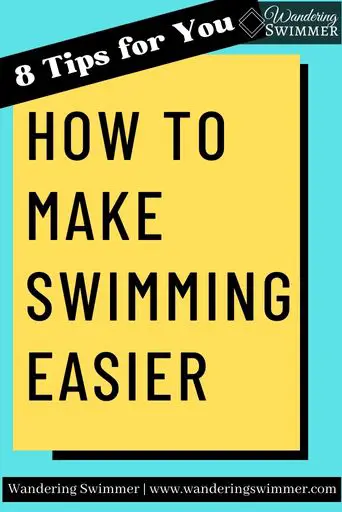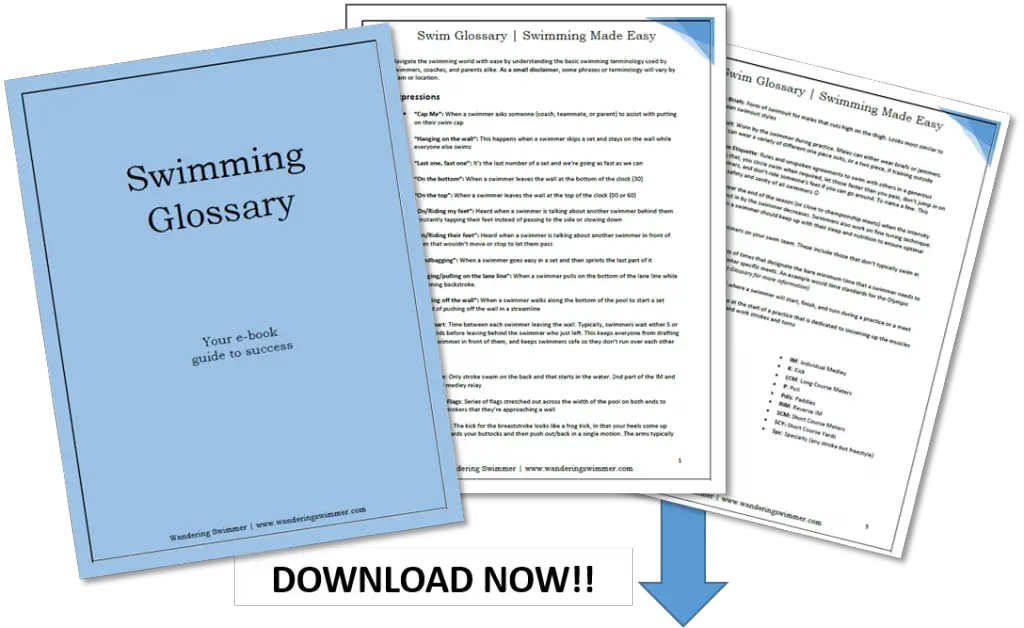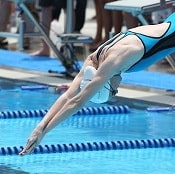Swimming is hard not just because it’s a full-body workout but also because it’s so technical. But just because it’s difficult doesn’t mean it needs to be a struggle. Here are 8 ways to make swimming easier and hopefully more enjoyable for you.
Related articles:
Disclosure: This post may contain affiliate links, meaning we earn a small commission at no cost to you if you purchase something through one of our links. As an Amazon Associate, we earn from qualifying purchases. Please check out our disclosure page for more information

8 Ways to Make Swimming Easier
1. Ask a Pro
We’re not saying Olympian-level pro. But a coach, trainer, or most swimmers can give you more tips on your stroke than you would realize. They can also cut through most of the distractions and give you straightforward advice.
They’re also the best at looking at your stroke and pointing out what you’re doing wrong and how to fix the problems.
This can be something as simple as how to breathe to the side instead of the front. Or how to fix the timing of your breathing. Just as it can be a quick pointer to improve your kick and make it more efficient.
Related article: 8 Flutter Kick Drills to Learn How to Kick In Freestyle
Small pointers can make a large difference in swimming when it comes to correcting strokes. This is the same for beginners up to experienced competitive swimmers.
And even these small changes to your stroke can make swimming easier.
Asking a coach or a swimmer for advice can be okay if they’re not busy at a workout themselves. If they look busy then try to ask before or after a workout as some coaches and swimmers don’t like to be bothered during a workout.
If you plan to consistently ask a swimmer or coach for advice and feedback, you should consider giving some type of compensation for their time. A gift card, money, or gift can go a long way to show your appreciation.
And of course, you should always thank them for their time and advice. It goes a long way, even if you’re only asking once or twice for feedback
2. Take Lessons or a Swim Class
This seems pretty straightforward but for some, it’s harder than most people think. Some of it comes down to pride and cost. Most teens and adults don’t want to admit that they can’t swim or that they struggle with the sport.
To which we say, you’re not alone! More people than you realize don’t know how to swim so you should have nothing to be embarrassed about.
If embarrassment is a concern of yours and is stopping you from taking swim lessons or a swim class, know that they have classes now for teens and adults. These instructors work specifically with older individuals who can’t swim and use different training techniques to help adults learn easier.
Related articles:
- A Quick Guide to Swim Lessons
- Make Learning to Swim Your New Year’s Resolution
- Your Complete Guide to Swim Lessons for Adults
- How to Find the Best Swim Instructor
Additionally, these classes (if held with others instead of individually) will have people around your age or ability. You may be surprised to see that you’re not the only one who struggles.
Can you learn to swim at an older age? Or course! Some would argue that you’ll learn quicker than kids because you can understand the concepts. So try your best not to feel ashamed that you can’t swim. Or that you can’t swim well.
You’re not the only one out there and the best way to make swimming easier is to start with help. Whether that’s with help from a coach or swimmer, or through lessons.
3. Work on Your Technique
Proper technique in swimming is extremely important. Better technique equals faster and easier swimming.
One of the reasons swimming is so hard is because it requires so much technical skill and work. It only stands to reason that to make swimming easier, you should work on your technique!
Competitive swimmers spend parts of practice doing drills and working technique in addition to the main parts of their workout. From doing kick and pull sets, to specific drill sets meant to focus on certain parts of a stroke, every bit of the workout helps swimmers focus on technique.
Related article: What do Swimmers do at Swim Practice?
If you have an instructor and someone you can ask for swimming advice, ask for swimming drills that you can use in your workouts. Drills help you develop your technique.
You can also utilize certain pieces of swimming gear such as paddles and fins to work on your strokes.
Paddles, such as FINIS Freestyle Paddles can help provide instant feedback on your freestyle stroke/pull. And swim fins, such as Arena’s Power Pro Fins can build up leg strength and develop a proper flutter kick.
Related article:
- A Swimmer’s Review of FINIS Freestyle Paddles
- 7 Best Swim Paddles for Swimmers
- The 10 Best Swim Fins for Swimmers
Even if you’re not doing any specific drills, you can still work and focus on your technique. Some good things to focus on when you’re swimming are:
- Make sure you’re breathing at the correct time and in the correct position
- Not kicking with your knees
- Developing a breathing pattern
- Keeping your stroke shoulder’s width apart
- Watch your head position so it’s not too low or high in the water
- Your hand should enter the water thumb first, not your pinkie
It takes time to build out good swimming techniques. Again, we recommend having someone watch your swimming stroke occasionally to see if/what you can improve. And if there is any feedback that they can give you.
4. Relax
Easier said than done but relax. You don’t swim well when you’re tense and your muscles aren’t relaxed.
When you’re body is tight and muscles tensed, you run the risk of sinking more in the water. Which can make it more difficult to keep your balance in the water and swim easier.
Instead, try to relax. Roll your shoulders forward and shake out your arms some. Take a few deep breaths to let the stress leave your body as best you can.
More Content for You:
Get your shoulders to relax, too. You’ll find that it’s easier to swim when your shoulders and up through your neck aren’t tight, as that’s where most of the arm rotation comes through. If you’re tight in your shoulders, you’re more likely to make your stroke tight and narrow.
If you find yourself tensing up again, stop at the wall for a bit to gather yourself and try again.
5. Breathe
Again, easier said than done. But you need to breathe. You need to breathe to complete your workout. 😉 And that means not trying to hold your breath for each length of the pool.
It’s tempting to hold your breath for as long as you can, take a breath, and then keep going. But it’s only going to make you dizzy before you can get into your workout.
One way to make swimming easier is to establish a breathing pattern.
Breathe every 2-4 strokes and you’ll find yourself falling into a rhythm. For some, it’s easier to keep swimming doing this rhythm. It’s also easier if you don’t overthink breathing and you don’t starve yourself of breath.
Related article: 7 Drills to Practice Side Breathing in Freestyle
You may need to take two breaths in a row if you do a flip turn off the wall and that’s okay! Once you feel comfortable, go back to your regular breathing pattern.
Another key to remember when it comes to breathing is to blow out bubbles just before you turn your head to get air. Bubbles are a swimmer’s best friend when it comes to breathing as they can help keep water from getting into your nose.
They’re also helpful in avoiding stitches in your side from breathing too much.
If you take too many breaths, you’ll pack in the oxygen and start to cramp. Instead, blow out some bubbles to exhale the remaining air and breathe back in the fresh air.
It takes time, yes. And you’ll probably end up with water up your nose more than once. But it helps form a breathing pattern and can make it easier. At the same time, it can also help you build lung endurance!
6. Focus on One Lap at a Time
A competitive swimmer will tell you that in a race, you have to take one lap at a time. And one turn at a time. As someone who competes in the individual medley, where you swim a distance of each stroke, not only do you take a lap at a time, you take one stroke at a time.
This is probably one of the best ways to make swimming easier.
It’s incredibly easy to get overwhelmed with how many laps left you have to swim in a workout. Or how much further you have to get back to where you started.
More Content for You:
But you can’t let yourself get caught up in the part that’s left. Doing that will make you stressed and overwhelmed. It’s also an easy way to make yourself feel discouraged and want to quit.
Instead, focus on the lap you’re on. Take it one stroke at a time until you get to the wall and then repeat. If you need to stop to collect yourself or catch your breath, then do so. Celebrate each lap you finish and then move on to the next one.
If you’re too focused on finishing the workout or what’s left, you’ll stop focusing on your technique. Rather, you should focus on your technique and trust that it’ll help you make it to the other side.
7. Consistency
Like with anything in life, consistency is key in swimming. Swimming becomes easier the more you work at it.
You don’t need to train twice a day and for six days a week like a competitive swimmer though 😉
Even getting in the water for an hour a day, at least 3-4 days a week can help you see improvements.
That said, even with this type of consistency, you won’t see results right away. It does still take time to build up swimming endurance and strength, especially if you’re just starting.
More Content for You: Your Quick Guide to Swim Caps
We would say that you should be able to double, if not triple, the number of laps you can swim after a few month, if you stay consistent with the time at the pool. Swimming does get easier the longer you stick with it.
8. Don’t Give Up
Competitive swimmers take 2-3 weeks off between each season. And just those 2-3 weeks off can take a month to get back into ‘swimming shape’.
That’s a month of working on drills and technique, building up endurance, and re-learning breath control before we feel like we have our stroke back again. It’s frustrating and you feel out of shape.
More Content for You: Can You Swim with Bad Eyesight?
That said, if you’re just starting to swim or have been working to improve your swimming bit by bit, know that it doesn’t happen overnight. It takes time and it takes not giving up to make progress.
A competitive swimmer will tell you that we train for hundreds of hours, for a 20-second to a few minutes race, just to drop 1/100th of a second.
And yes, swimming is hard. It’s a lot of work for a minimal reward at times. But when you keep going and don’t give up, the reward is worth it when you see all the progress you made.
In Closing
If there’s anything to take away from this it’s that you shouldn’t give up. Swimming is hard but when you take it lap by lap, and stroke by stroke, it can get easier.
Find yourself a swimming buddy or someone to give you stroke advice and keep working on your technique. You may find that with time and practice, swimming isn’t so hard after all!
As always, happy swimming!
Chevron
Bonus Content
The 7 Best Swim Shampoos to Remove Chlorine: The chemicals in the pool can leave your hair crunchy and straw-like. Here are the best swim shampoos to help reverse chlorine damage.
Ultimate Guide for Women’s Swimwear: Not all women’s swimwear are made the same. To help you find your perfect swimsuit, we’ve broken down various swimsuits for women.

Want to Improve at the Pool?
Join swimmers and swim parents to receive my free newsletter and receive a free Swimming Glossary e-book as a thanks!
Every month you’ll receive tips and coaching to help you find success at the pool.
About

Chevron is a current competitive swimmer with almost 20 years of experience in the pool. And although she fell into the sport by accident in her high school years, she still trains daily and competes throughout the year. She’s committed to providing guidance to all levels of swimmers and believes that everyone should know how to swim.